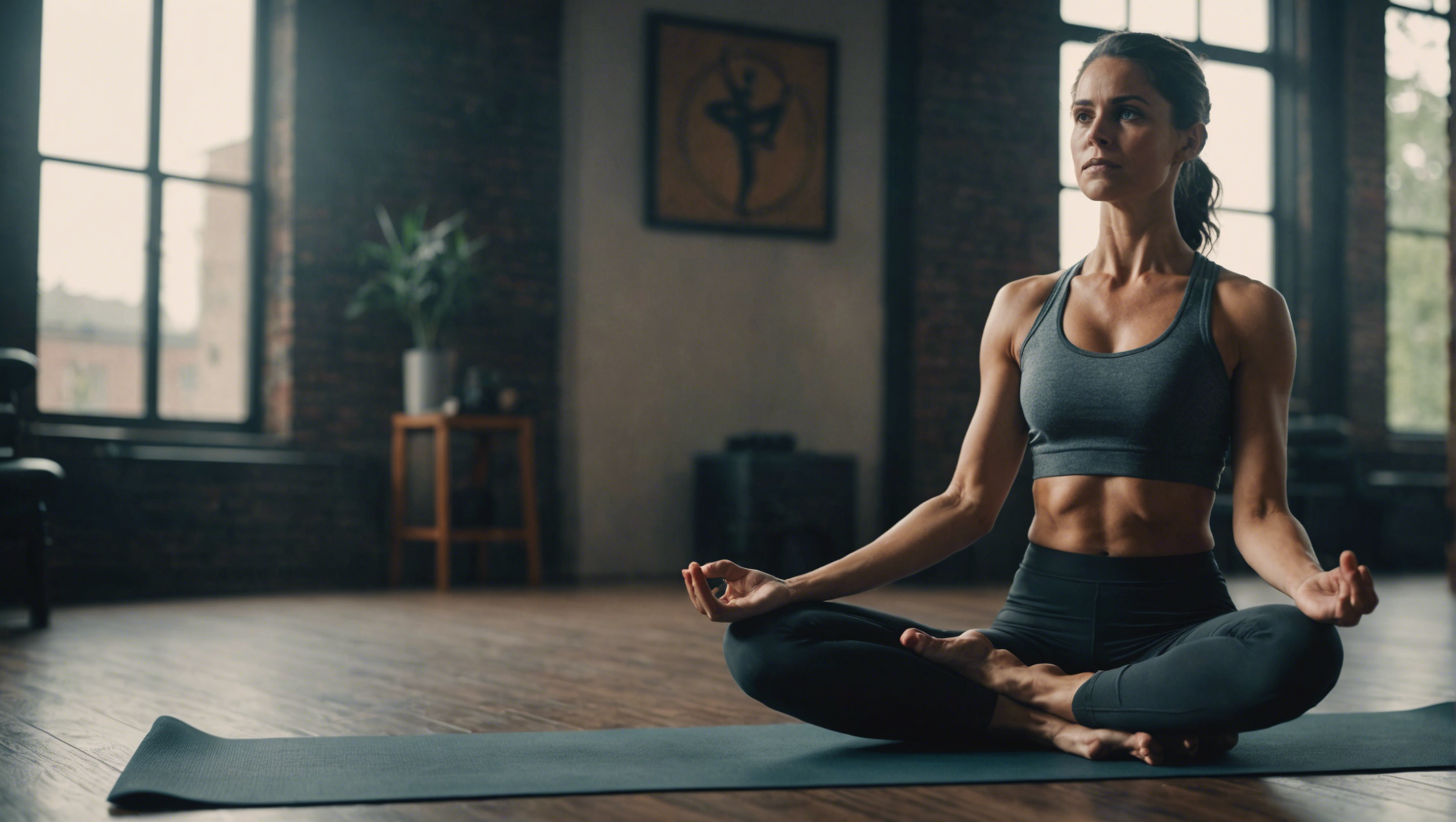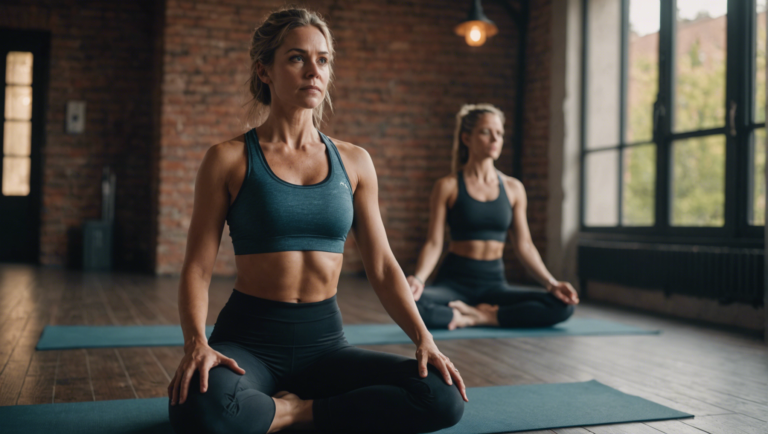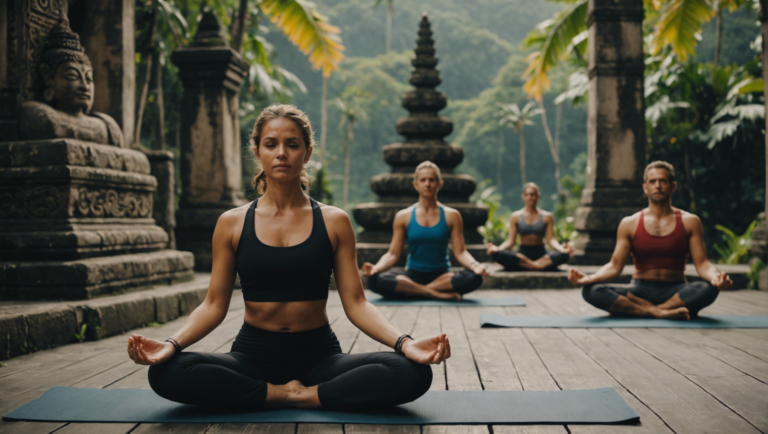Can Yoga Contribute To Muscle Building?
Can Yoga Contribute to Muscle Building? Unveiling the Connection
Yoga, often perceived as a peaceful practice for mindfulness and flexibility, harbors untapped potential in the realm of muscle building. While it might not conjure images of weight racks and protein shakes, yoga’s unique blend of strength, endurance, and balance exercises can indeed contribute significantly to muscle development. Through a deeper analysis, we unveil the intricate connection between yoga and muscle building, dispelling common myths and providing a clear understanding of how this ancient practice can sculpt and strengthen the body.
The Physiology Behind Yoga and Muscle Growth
Yoga stimulates muscle growth through isometric exercises—poses that activate muscles without visible movement. Holding a pose like Chaturanga or Warrior III creates tension in the muscles without changing their length, similar to pushing against an immovable object. This tension triggers the same physiological reactions in the muscle fibers that weight lifting does, promoting growth and strength.
Moreover, yoga enhances muscle tone by engaging multiple muscle groups simultaneously. Complex poses require a coordination that challenges the body to stabilize itself, engaging both primary and secondary muscle groups. Over time, this leads to improved muscle definition and strength.
The Role of Progressive Overload
To understand how yoga can contribute to muscle building, it’s crucial to consider the principle of progressive overload. In traditional weight training, this concept involves increasing the weight lifted over time to challenge the muscles continually. In yoga, progressive overload is achieved by transitioning to more complex poses, increasing the duration of holds, or introducing variations that add resistance or challenge balance further.
Yoga’s Impact on Core Strength and Stability
One area where yoga excels in muscle building is in the enhancement of core strength and stability. The core is the foundation for all movement, and a strong core supports better posture, reduces the risk of injury, and improves performance in other physical activities. Poses such as Plank, Boat, and Dolphin, demand significant core engagement, contributing to a solid and powerful midsection.
Flexibility and Muscle Recovery
Yoga’s contributions to muscle building extend beyond the immediate effects of the practice itself. Flexibility, a well-known benefit of yoga, plays a crucial role in muscle recovery and growth. Regular yoga practice increases flexibility, which can help prevent muscle soreness and stiffness. This not only aids in quicker recovery post-workout but also improves the range of motion, allowing for more effective engagement during muscle-building exercises.
Yoga into a Muscle-Building Regimen
To maximize yoga’s benefits for muscle building, it’s essential to tailor your practice towards poses that challenge strength and stability. Focus on sequences that include a variety of holds and incorporate movements that engage different muscle groups. Additionally, combining yoga with traditional strength training can create a balanced fitness routine that enhances muscle growth while providing the flexibility and recovery benefits essential for overall wellness.
Engaging with Expertise and Personal Experience
Drawing upon first-hand experiences and expert insights, it’s clear that yoga can be a potent tool for muscle building. Individuals who have integrated yoga into their fitness routines often report not only improvements in muscle tone and strength but also a greater awareness of body mechanics and alignment, which aids in the execution of other physical activities.
The Verdict: Yoga as a Muscle-Building Ally
Through a comprehensive analysis grounded in physiology and practical application, the connection between yoga and muscle building is undeniable. As practitioners challenge themselves with progressively more demanding poses, they activate and build muscle fibers, enhance core strength and stability, and improve flexibility for better recovery and muscle growth.
Yoga, with its holistic approach to wellness, offers a path to muscle building that transcends conventional methods. By emphasizing mindful movement, balance, and strength, yoga proves to be a valuable ally in not only shaping the body but also in fostering overall health and fitness.
The Science Behind Yoga and Muscle Growth: A Deep Dive
Yoga is often pigeonholed as a relaxing and stretching-centered activity, primarily focusing on mindfulness and breathing techniques. However, when delved into its practice deeply, it’s apparent that yoga’s benefits stretch far beyond just flexibility and mental well-being. It’s a multifaceted discipline that can significantly contribute to muscle building and strength training. Here’s an exploration into the science that links yoga with muscle growth, unpacking how this ancient practice can complement your physical fitness regime.
The Role of Resistance in Muscle Development
One of the foundational principles of muscle building involves resistance training — activities that induce muscular contraction against external resistance, leading to increased strength, tone, and mass. While weightlifting is the go-to method for many, yoga employs a different kind of resistance: the weight of one’s own body. Through various asanas (postures), practitioners engage specific muscle groups, holding positions that require strength and stability.
This bodyweight training not only challenges muscles through constant tension and release but also enhances proprioception — the awareness of one’s body in space. As muscles adapt to the resistance provided by bodyweight in dynamic and static postures, gradual strengthening and growth are experienced.
Static Holds and Muscle Hypertrophy
Muscle hypertrophy, the process of muscle fiber growth, is a key component in muscle building. Static holds in yoga, where poses are maintained for extended periods, can induce muscle hypertrophy much like lifting weights at the gym. These isometric exercises involve contracting a muscle or group of muscles against an immovable force, which over time leads to increased muscle mass and strength.
For example, poses such as Chaturanga Dandasana (Four-Limbed Staff Pose) and Plank engage the arms, shoulders, chest, and core simultaneously, exerting them in a manner similar to push-ups. This multiplicity not only aids in building muscle but also ensures a balanced development across the body, reducing the risk of injuries associated with repetitive strain.
Enhancing Muscle Elasticity and Injury Prevention
Yoga excels in improving muscle elasticity, thanks to its emphasis on stretching and flexibility. Flexible muscles are less prone to injuries, recover faster, and can sustain heavier loads. This aspect of yoga complements muscle building by allowing for greater range of motion, which is crucial for performing exercises and lifts with proper form. Furthermore, the deep stretching involved in yoga increases blood flow to the muscles, aiding in muscle repair and growth by delivering essential nutrients and oxygen.
The Integration of Mindfulness and Muscle Growth
The mental focus and mindfulness cultivated through yoga have direct implications for muscle growth. The mind-muscle connection — the conscious engagement of muscles during an exercise — is a critical factor in maximizing the efficiency of strength training. Yoga teaches practitioners to hone their focus, directing attention to the muscles at work, thereby enhancing this connection. Improved concentration and stress reduction through yoga also contribute to better sleep patterns and lower cortisol levels, both of which are vital for muscle recovery and growth.
The Verdict on Yoga for Muscle Building
Evidently, yoga offers unique advantages for muscle building that are often overlooked. Its practice incorporates resistance training, enhances flexibility, prevents injuries, and fosters a stronger mind-muscle connection — all essential components of an effective strength training regimen. While yoga alone may not replace conventional weightlifting for those seeking substantial muscle hypertrophy, it serves as a powerful complement to any fitness routine. Whether you’re a seasoned athlete or a fitness enthusiast, integrating yoga into your training schedule can lead to improved muscle strength, balance, and overall physical and mental health.
Embracing yoga for its muscle-building potential requires patience and persistence. The gradual progression through its levels of difficulty ensures that as one grows stronger, there’s always a next step to challenge oneself further. This ongoing journey not only shapes the body but also the mind, exemplifying the holistic benefits of this ancient discipline.
Top Yoga Poses for Enhancing Muscle Strength and Tone
Yoga is often envisioned as a practice for enhancing flexibility and reducing stress, yet it’s also a powerful tool for building muscle strength and tone. While it may not replace traditional weight lifting or high-intensity workouts, yoga offers a unique blend of muscle activation, balance, and endurance building that can significantly contribute to a stronger and more toned physique. Delving into specific yoga poses reveals how this ancient practice can be a cornerstone in your strength-training regimen.
The Power of Plank Pose
Often a core element of yoga sequences, the Plank Pose is a masterclass in full-body engagement. This pose not only fires up your core muscles but also strengthens your arms, shoulders, and legs. Holding the Plank Pose requires significant muscle endurance, which over time, helps in developing a strong and stable core, essential for overall body strength and muscle tone.
Transitioning into Chaturanga Dandasana
Chaturanga Dandasana, or the Four-Limbed Staff Pose, takes the plank to an advanced level. It demands muscle control and strength as you lower your body close to the floor, keeping your elbows close to your sides. This pose intensely works the triceps, pectoral muscles, and core, offering a challenging yet effective way to enhance muscle strength and endurance.
Embracing the Warrior Series
The poses within the Warrior series—Warrior I, Warrior II, and Warrior III—are renowned for their lower body benefits. They target the thighs, glutes, and calves while also engaging the core and arms for balance and stability. These poses not only improve muscle tone and strength but also promote better balance and body awareness.
Engaging with Chair Pose
The Chair Pose is deceptive in its simplicity. Mimicking the act of sitting on an invisible chair, this pose deeply engages the thighs and glutes, while the upward stretch of the arms also works the shoulders and chest. It’s an excellent pose for building lower body strength and can be a rigorous workout for the muscles when held for extended periods.
Strengthening with Boat Pose
Focusing on the core, the Boat Pose is a potent practice for targeting the abdominal muscles, hip flexors, and spine. Balancing on the sit bones and keeping the legs and upper body lifted engages and strengthens the core, promoting muscle tone and endurance. This pose also challenges your balance and stability, further engaging your muscles.
Diving into Dolphin Pose
The Dolphin Pose is an effective shoulder and upper back strengthener. It also works the core, arms, and legs. By supporting the body on the forearms and lifting the hips up and back, it provides a unique challenge to the muscles, offering an innovative way to build strength and improve muscle tone.
Yoga’s approach to muscle building is holistic, emphasizing not just the physical aspect but also mindfulness and breath control. This holistic engagement of body and mind contributes to better muscle activation and growth, enhancing strength and tone without the risk of injury common in more high-impact exercises. Through consistent practice, these yoga poses can be instrumental in developing a strong, toned, and balanced physique.
Yoga transcends mere physical practice; it’s a journey of connection between body, mind, and spirit. By incorporating these poses into your routine, you embark on a path that not only strengthens the muscles but also fosters inner strength and balance. The transformative power of yoga in building muscle strength and tone is undeniable, making it an invaluable component of any fitness routine.
Incorporating Yoga into Your Strength Training Routine
Merging Yoga with Your Strength Training Regimen
Blending the ancient practice of yoga with modern strength training routines offers a transformative approach to fitness that benefits the body and mind. This comprehensive strategy not only enhances physical strength and flexibility but also fosters mental clarity and resilience. The journey towards a balanced and holistic fitness regimen can be profoundly rewarding, and here’s how to engage in this synergistic approach effectively.
The Foundation: Understanding the Symbiosis
Yoga and strength training might seem like two ends of the fitness spectrum, but they complement each other more than you might think. Where strength training focuses on muscle hypertrophy and power, yoga emphasizes flexibility, mobility, and balance. Together, they create a well-rounded fitness regimen that addresses multiple aspects of physical and mental health. This fusion can lead to improved performance, reduced injury risk, and a greater sense of well-being.
Step 1: Start with Fundamental Yoga Poses
Before diving into more complex practices, mastering fundamental yoga poses (asanas) is crucial. Poses such as Plank, Warrior II, Downward-Facing Dog, and Chair Pose not only build a solid foundation for more advanced yoga practices but also benefit strength training by enhancing flexibility, balance, and core strength. Consistently practicing these basic asanas can significantly improve your range of motion, making it easier to perform strength training exercises effectively and safely.
Step 2: Embrace Active Recovery with Yoga
Active recovery days are essential in any strength training regimen, allowing muscles to heal and grow stronger. Integrating yoga into these days can expedite the recovery process, reduce muscle soreness, and increase flexibility without overstraining the body. Gentle yoga sequences focusing on stretching and mindfulness can provide the necessary rest your body needs while still keeping it engaged.
Step 3: Enhance Mobility and Range of Motion
Increased mobility and an expanded range of motion are two significant benefits of practicing yoga that can greatly enhance your strength training efforts. Movements in yoga stretch and lengthen the muscles, tendons, and ligaments, allowing for more profound and safer lifts. Implementing yoga poses that target areas typically stiffened by strength training, like the hips, shoulders, and hamstrings, can lead to more effective workout sessions.
Step 4: Strengthen the Mind-Body Connection
Yoga’s emphasis on mindful movement and breathwork can sharpen focus and mental clarity, translating to better concentration and intent during strength training. This heightened awareness can improve form, technique, and execution, minimizing the risk of injury and maximizing the efficacy of each workout. Furthermore, mindfulness practices integrated from yoga can enhance mental resilience, aiding in overcoming plateaus and staying committed to fitness goals.
Step 5: Build a Customized and Balanced Routine
Crafting a routine that harmoniously blends yoga and strength training involves consideration of personal fitness goals, preferences, and schedules. A balanced weekly plan might include three days of strength training, two days of yoga, and two days of active recovery or rest. Listening to your body and adjusting the intensity and frequency of workouts is essential for sustainable growth and progress.
In this holistic approach to fitness, the fusion of yoga and strength training offers a comprehensive pathway to achieving not only physical strength and flexibility but also mental resilience and a deeper connection with oneself. By thoughtfully blending these practices, individuals can enjoy a balanced, healthy, and fulfilling lifestyle that transcends conventional workouts, leading to lasting health and wellness benefits.
Debunking Myths: Yoga for Muscle Building vs. Traditional Weight Training
Uncovering the Truth: Yoga and Muscle Strengthening
When embarking on a journey of physical transformation, the paths of yoga and traditional weight training often emerge as divergent routes, each with its own set of myths and misconceptions. At the heart of the discussion is a fundamental question: can yoga truly contribute to muscle building, or is it in a league distinct from conventional weight-lifting practices?
Revisiting the Essence of Muscle Building
To explore this, it’s essential first to understand what muscle building entails. At its core, muscle hypertrophy—the scientific term for muscle growth—occurs when muscle fibers are subjected to stress, causing them to repair and grow thicker. This process is traditionally achieved through resistance training, wherein weights create tension that tears muscle fibers, thereby initiating growth during the repair phase.
Yoga: A Different Approach to Resistance
Yoga, often perceived exclusively as a vehicle for flexibility and mindfulness, surprisingly parallels traditional strength training in its capacity to promote muscle growth. Instead of external weights, yoga uses body weight to create resistance. Poses such as Chaturanga (Four-Limbed Staff Pose), Virabhadrasana (Warrior Pose), and Plank engage multiple muscle groups, leveraging gravity and one’s own body weight to stimulate muscle fibers.
Scientific Insight into Yoga’s Muscle Building Capability
Recent studies have shed light on yoga’s efficacy in muscle strengthening. A notable investigation published in the Journal of Bodywork and Movement Therapies observed significant improvements in muscle strength and endurance among participants who practiced yoga regularly over an eight-week period. These findings underscore yoga’s potential as a viable muscle-strengthening practice.
Beyond Muscle: Holistic Benefits of Yoga
While traditional weight training predominantly focuses on muscle hypertrophy, yoga offers a more holistic approach to physical health. It not only helps in muscle toning but also enhances flexibility, balance, and mental well-being. This comprehensive approach not only contributes to a more well-rounded physical condition but also supports injury prevention and mental resilience—key components often overlooked in standard resistance training routines.
Blending Modalities for Optimal Results
The ideal physical regimen may not necessitate choosing between yoga and weight training. Instead, integrating both can yield a synergetic effect, enhancing overall fitness and body composition. While weight training increases muscle mass and strength, yoga complements by improving flexibility, muscle endurance, and recovery, thereby creating a balanced and sustainable fitness practice.
Navigating Misconceptions and Embracing Diversity in Training
Dispelling the myth that yoga cannot contribute to muscle building requires a nuanced understanding of what strength entails. It’s crucial to recognize that muscle strength doesn’t solely equate to muscle bulk. Yoga develops functional strength by improving muscle endurance and flexibility, which, in many practical scenarios, proves just as essential as the brute strength typically associated with weight lifting.
Tailoring Practice to Individual Needs and Goals
Ultimately, the choice between yoga, traditional weight training, or a hybrid of both should be informed by individual fitness goals, preferences, and physical conditions. For those seeking to enhance muscle strength while also pursuing flexibility, balance, and mental well-being, yoga offers a valuable and effective modality. Conversely, for individuals focused on maximizing muscle size and definition, traditional weight training might play a more central role, supplemented by yoga to ensure comprehensive physical health.
Engaging with Expertise for Personalized Guidance
Consulting with fitness professionals who understand the intricacies of both yoga and traditional weight training can provide personalized guidance. Tailored advice ensures that individuals embark on a fitness journey that respects their bodies’ limits and aspirations, fostering a sustainable and fulfilling path to physical excellence.
Final Thoughts
The dialogue surrounding yoga and muscle building, versus traditional weight training, invites a broader understanding of what constitutes strength, health, and well-being. By debunking myths and exploring the science behind various fitness practices, individuals can make informed choices that align with their holistic health ambitions, embracing the diverse benefits that yoga and weight training, together, have to offer.
Conclusion
Embarking on a journey through the intricate relationship between yoga and muscle building, we’ve uncovered compelling evidence and workshop techniques that not only demystify but also celebrate the potent blend of physical artistry and strength development inherent in yoga practice. By initiating our exploration with a provocative inquiry—can yoga contribute to muscle building?—we opened a gateway to a fascinating juxtaposition of ancient discipline and contemporary fitness objectives, revealing a symbiotic connection that enriches both realms.
Delving into the scientific underpinnings, we unearthed the physiological mechanics through which yoga acts not just as a complement to muscle building but as a potent force in its own right. Through emphasizing the controlled, mindful engagement of muscle groups and the fostering of muscular endurance and flexibility, yoga emerges as a multi-dimensional partner to traditional strength training methodologies. This deep dive into the biomechanics and metabolic responses associated with yoga practice illuminated the transformative potential that lies within its disciplined embrace.
In highlighting specific yoga poses known for their muscle-strengthening benefits, our journey took a practical turn, providing a toolkit for those seeking to enhance muscle tone and strength. Poses like Chaturanga Dandasana, Virabhadrasana, and Adho Mukha Svanasana aren’t merely static positions but dynamic engagements that challenge the body’s musculature across various planes, promoting growth, endurance, and resilience. Such revelations serve as a bridge, connecting the philosophical roots of yoga with the grounded, tangible goals of muscle augmentation.
Integrating yoga into an existing strength training routine emerged as not only feasible but profoundly beneficial, offering insights into constructing a holistic approach to physical wellness and prowess. This integration fosters a balanced regimen wherein the flexibility and mindfulness cultivated through yoga complement the intensity and focus of weight training, reducing the risk of injury and enhancing overall physical conditioning. This synergy underscores the idea that the pursuit of strength need not be unilateral but can be beautifully diverse in its expression and methodology.
Addressing the contrasting perspectives on yoga and traditional weightlifting led to an enlightening discourse on the multifaceted nature of muscle building. Debunking common myths, the discussion clarified that yoga, with its emphasis on holistic health, mindfulness, and body awareness, does not serve as a direct substitute for weight training but rather as a powerful adjunct. The nuanced understanding that emerged advocates for a personalized fitness journey, one that honors the unique needs, goals, and joys of each individual.
The convergence of yoga and muscle building, as explored throughout this discourse, invites a broadened perception of strength, one that transcends mere physicality to encompass mental fortitude, emotional resilience, and a deep-seated harmony between body and spirit. It challenges entrenched stereotypes and celebrates the diversity of paths leading to physical empowerment and wellness.
Armed with the knowledge and insights distilled from an exploration of yoga’s multifarious benefits, it becomes clear that the question is not whether yoga can contribute to muscle building, but how we can most effectively harness its profound capacities to complement and enrich our strength training endeavors. In venturing beyond conventional boundaries and embracing a holistic approach to muscle building, we open ourselves to a world of potential where physical strength is inextricably linked with mental clarity, emotional balance, and a profound sense of interconnectedness.
This exploration educates and empowers, inviting practitioners and skeptics alike to reimagine the landscape of fitness and wellness. It is a call to action—not only to embrace yoga as a significant ally in the quest for physical strength but to cultivate a deeper, more harmonious relationship with our bodies and the myriad ways we can nurture, challenge, and ultimately transform them.



